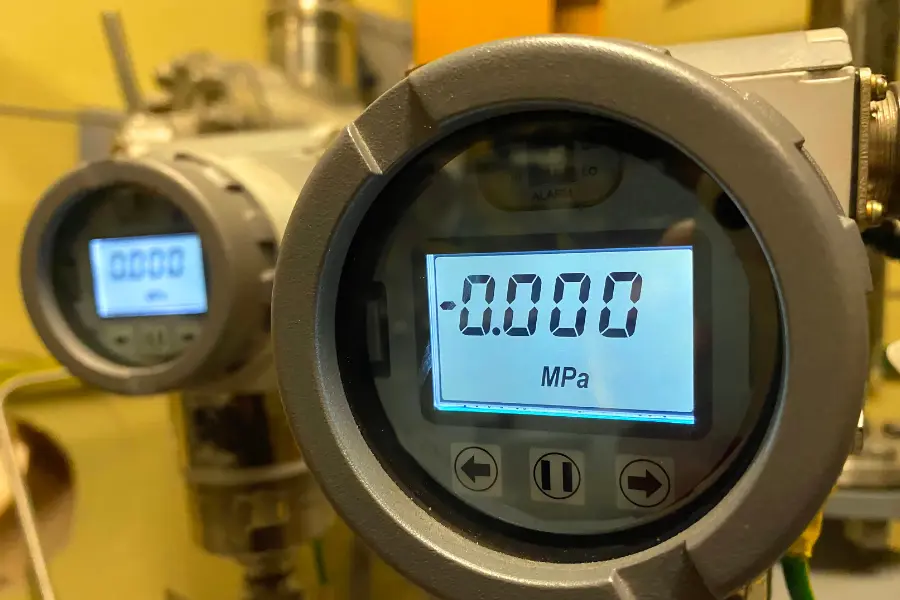This level sensor detects when the water level in a container is either too low or high and alerts the user accordingly. Level gauges can be classified as either “contact type” or “non-contact type,” depending on how liquid is detected.
Our so-called “contact measurement” water level transmitter takes input from the surface of the liquid and then uses that measurement to generate an electrical signal. It is a common water level sensor today.
Water level sensor: how does it work?
As a type of pressure transmitter like these, a water level sensor measures the depth of a liquid by translating the pressure exerted on its front surface by the fluid into an electrical signal. P=p.g. H+Po is the formula used in the calculation.
Suppose we plug these values into a formula. In that case, we get P = H+Po, where P is the pressure at the sensor’s liquid surface, p is the liquid’s density being measured, g is the acceleration of gravity at the sensor’s location, Po represents the air pressure at the surface of the liquid, and H is the height at which the sensor is submerged.
The level sensor detects and quantifies the presence of liquids. When the sensor determines that liquid is present, it transforms the information it has determined into an electronic signal. Reservoirs, oil storage facilities, and river levels are the most common applications for level sensors.
Where should water level sensors be used?
The following are some examples of how we can put water level sensors to use:
- Pool and water storage tank water level gauges
- Taking readings of the water levels in lakes and rivers
- Measuring Sea Level
- Measuring the Depth of Acid-Base Solutions
- The measurement of the amount of oil in mailboxes and oil trucks
- Regulation of Water Depth in Swimming Pools
- Sea-level-rise forecasting and tsunami warning
- Regulation of water levels in cooling towers
- Regulating the liquid level in sewage pumps
- The ability to remotely monitor the amount of fluid present
How useful are water level sensors, and what are their advantages?
Simple structure
Because there are no moveable or elastic components, the level of dependability is exceptionally high, and there is no requirement for routine maintenance while the product is being used. The process is easy and practical to use.
Simple set up
When you are ready to use it, first ensure that one end of the wire is correctly connected, and then insert the other end of the probe into the fluid that is being measured.
Optional ranges
You can measure the water level across a range of 1–200 meters, and different ranges are available per request.
Multiple uses in various fields
This liquid level gauge works well with media with extreme conditions, such as high temperature, high pressure, severe corrosion, and high pollution. It is possible to keep tabs on the tides by installing an electrical water level indicator on the riverbank.
Extensive Scale of Measurement
The foaming, electrical, and deposition characteristics of the measured substance do not affect the accuracy of the wide-range temperature correction, allowing for measurements in various media, from water to paste to oil with a high viscosity.
High durability
In a typical environment, liquid-level sensors have a life expectancy of 4-5 years; however, in a hostile environment, they only have a life expectancy of 2-3 years.
Multiple functions
Connecting it to a digital display meter shows the value in real-time, while connecting it to a controller allows you to limit the amount of water added or removed from the container.
Accurate measurement
The precision of the readings is excellent because of the high-grade sensor that is included in the device; it is sensitive to little changes in liquid levels, whether they be moving or stationary.
Many different types
Different types of liquid-level sensors have different physical constructions. These include the input type, flange type, straight rod type, thread type, screw-in type, float type, an inductive type. It can be adjusted to accommodate any region’s unique requirements for quantitative analysis.
Ultrasonic water level sensors, low water level sensors, radar water level transmitters and submersible water level sensors, etc., are just some of the many level sensors from MicroSensor. These sensors are a great investment with precise performance, superior functionality, robust construction, and a long lifespan.
You can be certain that you are not getting ripped off when you buy a water level sensor from us because they are compatible with many different measuring mediums.
Get in touch with us immediately for expert advice on the best smart-level sensors for your company, whether you need them to monitor hydrostatic water levels, the level of an industrial compound, or anything else.



![10 Best Bags for Nurses | Personal Recommendation [2023] 6 Best Bags For Nurses Reviews in 2021](https://knowworldnow.com/wp-content/uploads/2022/12/Best-Bags-For-Nurses-Reviews-in-2021.webp)



![F95Zone Games - The Ultimate Guide for 2021 [F95Z Guide] 10 F95Zone Games](https://knowworldnow.com/wp-content/uploads/2021/07/ArTtW5LrK3b-z-0-y-637f48d86203817a9042a857.webp)